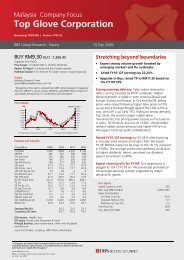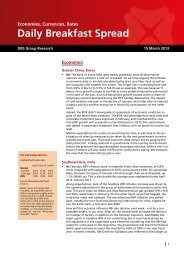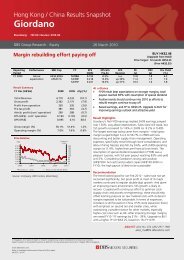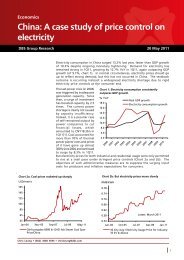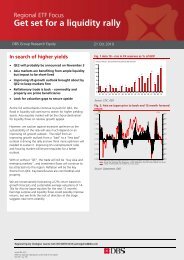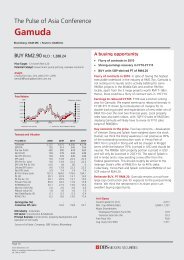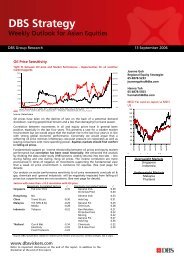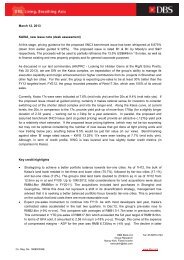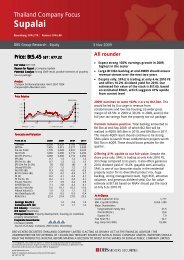Economics Markets Strategy - the DBS Vickers Securities Equities ...
Economics Markets Strategy - the DBS Vickers Securities Equities ...
Economics Markets Strategy - the DBS Vickers Securities Equities ...
You also want an ePaper? Increase the reach of your titles
YUMPU automatically turns print PDFs into web optimized ePapers that Google loves.
<strong>Economics</strong> – <strong>Markets</strong> – <strong>Strategy</strong><br />
<strong>Economics</strong><br />
What’s <strong>the</strong> difference in terms of economics? Any textbook would say that <strong>the</strong><br />
first picture, 1979-84, is one of prices being driven by a contraction in supply.<br />
And it would say that <strong>the</strong> o<strong>the</strong>r picture, from 2002 to 2008, shows prices being<br />
driven north by an expansion in demand.<br />
And what would one expect for <strong>the</strong> direction of industrial output in <strong>the</strong>se two<br />
situations? That a contraction in oil supply would bring a sharp contraction in<br />
industrial output along with <strong>the</strong> surge in prices. Plainly, that’s what happened<br />
in <strong>the</strong> oil crises of 1973-75 and 1979-83. In 1973, oil prices rose by a factor of<br />
nearly four in six months and G3 industrial output dropped by 12% in very<br />
short order. In some countries, like Japan, industrial production fell by 20%. In<br />
<strong>the</strong> second oil crisis, prices tripled in <strong>the</strong> 12 months ending Nov79 and were<br />
subsequently maintained <strong>the</strong>re for <strong>the</strong> next three years. G3 industrial production<br />
fell for three years, by a total of 8%.<br />
G3 – industrial production and crude oil, 1973-75<br />
Nov73=100, sa<br />
wt avg ccy unit/bbl, Nov73=100, Brent<br />
G3 – industrial production and crude oil , 1979-84<br />
Jan80=100, sa<br />
avg ccy unit/bbl, Jan78=100, Brent<br />
100<br />
98<br />
96<br />
Oil<br />
price<br />
(RHS)<br />
400<br />
350<br />
300<br />
102<br />
100<br />
98<br />
Oil<br />
price<br />
300<br />
275<br />
250<br />
225<br />
94<br />
92<br />
90<br />
88<br />
IP<br />
(LHS)<br />
250<br />
200<br />
150<br />
100<br />
96<br />
94<br />
92<br />
Oil<br />
price<br />
triples<br />
in one<br />
year<br />
IP falls<br />
10%<br />
over 3<br />
years<br />
IP<br />
(LHS)<br />
200<br />
175<br />
150<br />
125<br />
100<br />
86<br />
Jan-72 Jan-73 Jan-74 Jan-75 Jan-76 Jan-77<br />
50<br />
90<br />
Jan-78 Jan-80 Jan-82 Jan-84<br />
75<br />
By contrast, when higher oil prices are driven by demand, one would expect to<br />
see a more gradual rise in price along side an uninterrupted rise in output –<br />
precisely <strong>the</strong> picture seen in <strong>the</strong> global economy since it last hit bottom in<br />
Dec01. One such picture (for <strong>the</strong> G4 overall) was shown on page 8. Two additional<br />
pictures of Asia – with and without China/India – are shown below.<br />
Asia 10 – industrial production and crude price<br />
Jan02=100, sa<br />
wt avg ccy price, Jan02=100, Brent<br />
Asia 8 – industrial production and crude price<br />
Jan02=100, sa<br />
wt avg ccy price, Jan02=100, Brent<br />
200<br />
600<br />
180<br />
600<br />
175<br />
150<br />
IP<br />
(LHS)<br />
500<br />
400<br />
160<br />
140<br />
IP<br />
(LHS)<br />
500<br />
400<br />
300<br />
300<br />
125<br />
100<br />
Oil<br />
price<br />
(RHS)<br />
200<br />
100<br />
120<br />
100<br />
Oil<br />
price<br />
(RHS)<br />
200<br />
100<br />
75<br />
02 03 04 05 06 07 08 09<br />
0<br />
80<br />
02 03 04 05 06 07 08 09<br />
0<br />
11



